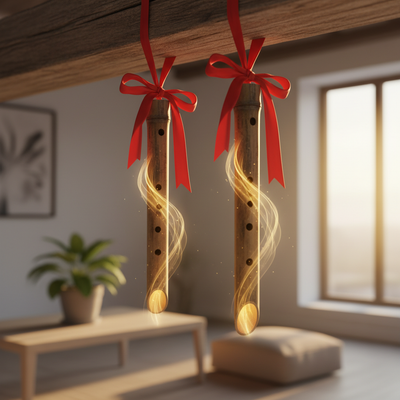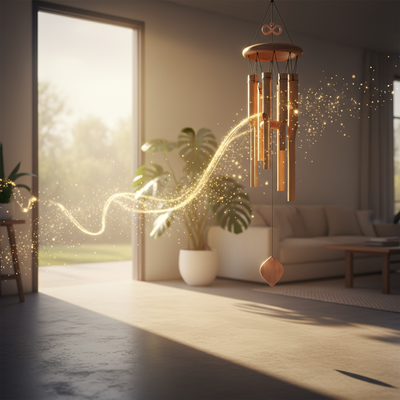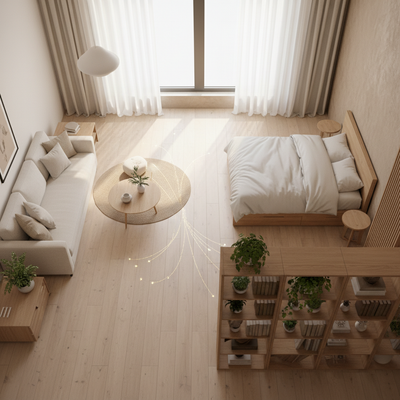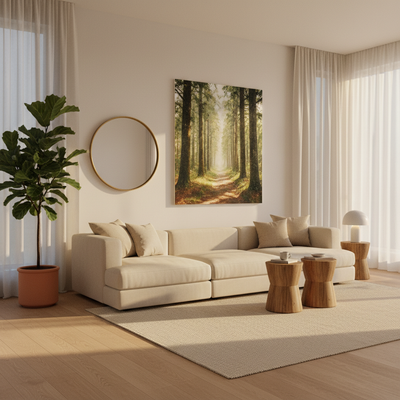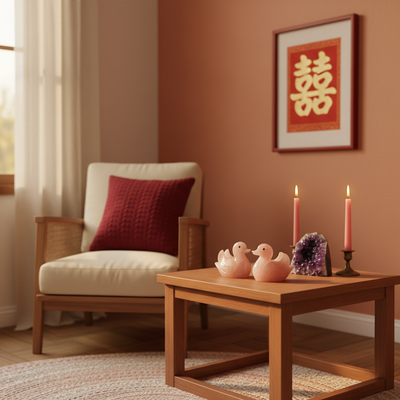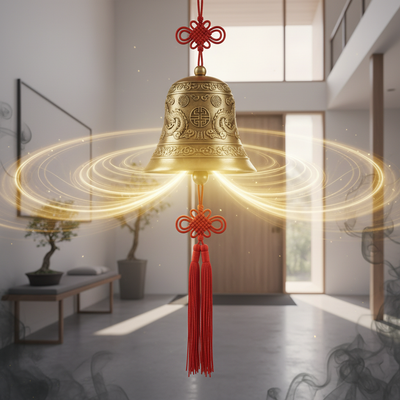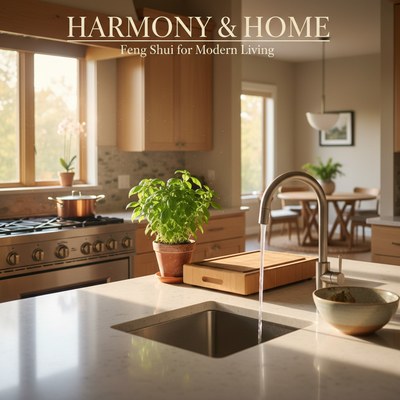The pictures we put in our bedrooms do more than just look nice. They are like silent messengers that constantly affect our minds without us realizing it, changing how we sleep, feel, and get along with others. In Feng Shui, the art in your most private space isn't just sitting there doing nothing. It actively helps shape the energy, called Qi, in your room. The main rule is easy but important: your art should show peace and partnership. All pictures should make you feel love, calm, connection, and balanced togetherness. It's about creating a visual plan for the life and relationships you want. In this guide, we will look at the best pictures to bring in good energy, which images to stay away from, where to hang them, and the basic ideas that make this practice work so well.
The Good 'Yes' List

Picking the right art takes away the guesswork and helps you choose pieces that will make your bedroom better. The goal is to surround yourself with visual hints that help with rest, love, and stability. Think of your bedroom art as a soft, constant reminder of your deepest wishes for your personal life.
The Power of Two
In Feng Shui, the number two is very important for the bedroom. It represents the partnership, love, and togetherness you want to build. Single images can make your mind think of being alone, while pairs create an energy of connection. This is the most simple and powerful rule to use when picking your art.
- A pair of mandarin ducks, a classic and strong symbol of lifelong loyalty and happy marriage.
- Two birds flying together, showing a shared journey and freedom within a partnership.
- Two blooming flowers on one stem, like peonies or orchids, symbolizing shared growth and beauty.
- Two strong, twisted-together trees, meaning a solid, supportive, and lasting relationship.
Romantic Couple Pictures
Art showing a happy couple can be a beautiful addition, but you need to choose carefully. The focus should be on loving, committed partnership. This can be an abstract picture of a hug, a tasteful personal photo, or a painting of two people walking together. The key is the feeling it creates. The image should give off joy, warmth, and deep connection. Avoid anything too sensual or passionate, as this brings too much active 'Yang' energy into a space that should be mostly restful and 'Yin'.
Gentle Nature Scenes
Landscapes can be very grounding and healing in a bedroom, as long as they feel supportive and rich. Look for scenes that you could imagine comfortably walking into with a partner. Think of rolling green hills under a soft sky, a lush and blooming garden, or a peaceful forest path wide enough for two. The view should feel welcoming and inclusive, not huge and isolating. These images connect us to the stable, nurturing energy of the Earth element, creating a sense of security and peace.
Soft, Flowing Abstract Art
Abstract art is a great choice for a feng shui bedroom because it shows mood and energy without showing actual things. This lets you set a specific energetic tone in a sophisticated and subtle way. Choose pieces that have soft curves, flowing lines, and colors that work well together. Earth tones, soft pastels, and warm, skin-like colors are especially good. Avoid art with sharp, jagged lines, chaotic compositions, or clashing, aggressive colors, as these can create a feeling of hidden tension and disrupt sleep.
The 'No-Go' Zone
Just as important as knowing what to hang is knowing what to avoid. Certain types of pictures can unknowingly bring negative or disruptive energy into your sanctuary, working against your goals of rest and romance. Protecting your bedroom from these influences is a critical step in creating a peaceful space.
Single Figures or Objects
A single person, a lone tree on a windy hill, or a single boat on the water can make your mind feel lonely and isolated without you knowing it. Even if the image is beautiful, its main message is about being alone. In the bedroom, the room meant for partnership, this creates an energy conflict. Always ask yourself: does this image show togetherness or being alone?
Aggressive or Sad Pictures
This may seem obvious, but it's a common mistake. Your bedroom is for rest, healing, and closeness. Any art that makes you think of struggle, fear, sadness, or aggression really disrupts this purpose. This includes images of predators, battle scenes, dramatic storms, abstract pieces that feel chaotic, or people who appear to be crying or upset. The energy of these images is active and stressful, directly going against the calm, 'Yin' state needed for deep sleep.
Water, Water Everywhere
This is one of the most well-known but often misunderstood Feng Shui rules. Large, prominent images of water—such as oceans, powerful rivers, or waterfalls—are generally not recommended in the bedroom. Energetically, water is always moving and can symbolize instability or emotional overwhelm. In traditional Feng Shui, it can also be linked to the energy of worry or even money loss when placed incorrectly. A small, still pond within a larger, lush landscape might be okay, but a dominant water feature is best placed in other areas of the home.
Photos of Family and Friends
We love our family, friends, and children, and their photos are treasures. However, they belong in the more social, 'Yang' areas of the home, like the living room or hallway. In the bedroom, many photos, especially of children or parents, can create a subtle feeling of being watched. This can prevent closeness between partners and disrupt the main function of the room as a private retreat for the couple. The energy of the bedroom should focus only on the partners who live there.
Stimulating or Religious Pictures
The bedroom is not the place for mentally stimulating or overly active energy. Powerful religious icons, while spiritually important, often carry a very strong, active 'Yang' energy that is better suited for a special meditation space, altar, or study. Similarly, art that is intellectually complex or designed to make you think deeply can keep your mind "switched on" when it should be winding down for sleep.
| Use in the Bedroom | Avoid in the Bedroom |
|---|---|
| Images of loving pairs (people, animals) | Single, solitary figures or objects |
| Gentle, lush nature scenes | Aggressive, chaotic, or sad scenes |
| Soft, flowing abstract art | Prominent images of water |
| Symbols of your shared goals | Photos of family, friends, or children |
| Art with warm, earthy, or soft colors | Overly stimulating or powerful religious icons |
The Art of Placement
Once you've chosen good art, where you hang it is the next critical step. Placement determines how you interact with the art's energy and directs its influence toward specific goals. Strategic positioning turns your pictures from simple decor into powerful energetic tools.
The Wall You See First
The first thing you see when you wake up sets the tone for your entire day. Because of this, the wall across from your bed is a prime location for an inspiring and positive piece of art. Placing an image here that represents your goals—whether it's a picture symbolizing partnership, a landscape showing peace, or an abstract piece radiating warmth—is a powerful way to start each day with the right intention. It becomes your morning's first visual affirmation.
Above the Headboard
The wall above your bed's headboard is energetically connected to your stability and support in life and in your relationship. Art placed here should feel calming, supportive, and, importantly, be physically light. A single, wide landscape painting that creates a stable horizon line is an excellent choice. A soft abstract piece can also work well. A critical safety and energetic note: always avoid heavy, glass-framed artwork directly above where you sleep. Choose a lightweight canvas and make sure it is mounted securely. The energetic weight of a heavy object hanging over your head can create unconscious anxiety.
The Bedroom Bagua Map
The Bagua is the Feng Shui energy map that applies to your home and to each individual room. To locate your Relationship Corner (Kun area), stand at the doorway of your bedroom looking in. The far-right corner of the room is the Kun area, which governs love, partnership, and marriage. This is the most powerful area to place art that specifically supports your relationship goals. Images of pairs, romantic art, or personal photos of you and your partner looking happy together are ideal for activating the energy in this corner.
Size, Scale, and Framing

Balance is a key principle in Feng Shui. The scale of your artwork should match the wall and the furniture it hangs above. A tiny picture on a huge, empty wall will feel lost and its energy weakened. On the other hand, a massive piece on a small wall can feel overwhelming and oppressive. Aim for art that is roughly two-thirds the width of the furniture below it (like a headboard or dresser). The frames also contribute to the room's energy. Wood frames add grounding Earth and Wood element energy, while thin, rounded metal frames bring in the clarity of the Metal element.
Creating an Energy Story
Beyond selecting a single perfect picture, you can improve your practice by creating a thematic "Energy Story." This is the intentional selection of 2-3 pieces of art and decor that work together to visually and energetically support a specific goal. It's about creating a complete visual story for your space.
What is an Energy Story?
An Energy Story goes beyond individual rules to create a unified theme. It's a collection of art, objects, and textiles that, when viewed together, tell a consistent story about the life you are building. This advanced technique allows you to act as a conscious creator of your environment, aligning your entire bedroom's visual landscape with your deepest intentions.
Theme 1: Deep Rest & Renewal
This theme is for anyone feeling burnt out, stressed, or in need of deep healing. The energy is deeply 'Yin'—calm, restorative, and gentle.
- Piece 1 (Above Bed): A wide, abstract canvas with soft, horizontal strokes in deep blues, earthy taupes, and soft grays, creating a calm horizon and deep peace.
- Piece 2 (Across from Bed): A detailed botanical print of a fern gently unfurling or a series of prints showing the life cycle of a plant, symbolizing gentle growth and renewal.
- Piece 3 (On Dresser): A small, smooth stone sculpture or a simple ceramic piece with a soft, rounded shape, adding a touch of grounding Earth energy.
Theme 2: Partnership & Adventure
This theme is designed for couples looking to deepen their connection, spark romance, and foster a sense of a shared journey.
- Piece 1 (Relationship Corner): A tasteful diptych (a two-panel artwork) showing two birds in a blooming cherry tree, representing a flourishing partnership.
- Piece 2 (Across from Bed): A beautiful, softly lit photograph of a destination you both want to visit, like a peaceful Tuscan landscape or a quiet mountain path, setting an intention for shared experiences.
- Piece 3 (On Nightstand): A single, palm-sized rose quartz crystal, the ultimate stone of unconditional love, placed on the nightstand in the Relationship Corner.
Create Your Own Story
We often guide clients through this creative process, which transforms their relationship with their space. It's a powerful exercise in manifestation. You can do it too:
- Define Your Intention: What is the number one feeling or goal you want your bedroom to support right now? Be specific. Is it more intimacy, better sleep, or creative inspiration?
- Brainstorm Symbols: List words, images, and colors that come to mind. For intimacy, you might list: togetherness, warmth, connection, peonies, embrace, soft pinks, earthy reds.
- Select Your Anchor Piece: Choose one main piece of art that most strongly represents your core intention. This will be the focal point of your story.
- Choose Supporting Pieces: Select one or two smaller pieces of art or objects that complement the anchor piece and reinforce the theme. They should feel like they are in conversation with each other.
- Arrange with Intention: Place the items thoughtfully, using the placement rules discussed earlier to maximize their energetic impact.
A Practical Example
Theory is helpful, but seeing it in action makes it real. Let's walk through a common scenario to see how changing the art can dramatically shift the energy of a bedroom.
The Scenario
We'll call our couple Alex and Ben. They love their home but have been feeling disconnected from each other. Their sleep has been restless, and the bedroom, despite being nicely furnished, feels cold and uninviting.
The 'Before' Analysis
A look at their bedroom art quickly reveals potential energetic drains.
- Above the Bed: They have a large, dramatic painting of a single ship navigating a stormy sea. Alex was drawn to its artistic merit, but its energy is one of struggle, danger, and solitude.
- Across from the Bed: On the wall they see first upon waking, there is a framed, black-and-white art poster of a busy, anonymous city street.
The Feng Shui diagnosis is clear. The ship painting introduces the energy of instability and crisis directly into their rest and relationship space. The city street scene is overwhelmingly 'Yang'—active, busy, and impersonal—which disrupts the calm needed for sleep and intimacy.
The 'After' Solution
Following a consultation, they decide to make a complete change, creating a new "Energy Story" focused on partnership and peace.
- Replace the Ship: They choose a beautiful, wide canvas print of two birds flying together into a soft, warm sunset. This is hung above the headboard.
- Replace the City Poster: On the wall across from the bed, they hang a series of three small, square frames, each showing a close-up photograph of soft pink peony petals.
The Reasoning
These changes create a deep energetic shift. The two birds symbolize a shared journey, freedom, and partnership. The warm sunset provides a sense of peaceful closure to the day and radiates warmth. The peonies are a classic Feng Shui symbol of love, romance, and prosperity. Their soft, rounded, and layered shapes are deeply 'Yin,' promoting a gentle, receptive, and loving atmosphere. The broken, chaotic energy is replaced with a unified story of peaceful togetherness.
The Professional Touch
For complex layouts or deeply rooted energy patterns, a simple art change is a powerful first step, but sometimes more is needed. This is where a professional consultation becomes invaluable. The QI FLOW team, for instance, specializes in conducting in-depth energy audits of a space. We help clients identify not just the obvious issues, like the wrong picture, but also the subtle imbalances in layout and element interaction, creating a complete solution that art alone cannot achieve. We've seen firsthand how a comprehensive approach can transform not just a room, but a client's entire sense of well-being.
Understanding the 'Why'
The advice for choosing and placing feng shui bedroom pictures is not random. It is rooted in foundational Feng Shui principles that have been observed for centuries. Understanding these core concepts builds trust and deepens your practice.
Qi: The Life Force
Qi (or Chi) is the invisible life force energy that flows through everything—our bodies, our homes, and the natural world. The goal of Feng Shui is to ensure that Qi flows smoothly and positively through our environment, supporting our health and goals. The pictures in our room directly influence the quality of the Qi. A calming image creates Sheng Qi (positive, life-enhancing energy), while a chaotic one can create Sha Qi (negative, draining energy).
Yin & Yang Balance
The universe is seen as a balance of two opposing but complementary forces: Yin and Yang. A bedroom should be a mostly 'Yin' space to promote rest, receptivity, and intimacy. Yin is characterized as calm, dark, soft, and quiet. Yang is active, bright, hard, and loud. Art with soft colors, gentle curves, and tranquil themes supports Yin energy. Art with bright, fiery colors, sharp lines, and busy scenes is 'Yang' and can be disruptive in a room for sleep.
The Five Elements
The Five Elements—Wood, Fire, Earth, Metal, and Water—are the building blocks of Qi. Each element is associated with specific colors, shapes, and qualities. Harmonizing these elements in your bedroom through art creates balance.
- Wood: Greens, Browns. Tall, columnar shapes. (Represents growth, vitality)
- Fire: Reds, Oranges, Pinks. Triangular, sharp shapes. (Represents passion, energy) - Use this element sparingly in the bedroom to avoid over-stimulation.
- Earth: Yellows, Sandy/Earthy Tones. Square, flat shapes. (Represents stability, grounding, nourishment)
- Metal: Whites, Grays, Metallics. Round, circular shapes. (Represents clarity, precision, joy)
- Water: Blacks, Deep Blues. Wavy, flowing shapes. (Represents flow, emotion) - Use this element with caution in the bedroom, as discussed.
Conclusion
Your bedroom art is an active and powerful tool for shaping your personal reality. By following these principles, you transform your walls from passive surfaces into an active vision board for your life. Remember the core message: choose images that reflect partnership and peace, avoid those that suggest loneliness or chaos, and place them with clear, loving intention. Creating feng shui bedroom pictures is a personal journey. Start with one small change, trust your intuition about what feels right for your sanctuary, and watch as the energy of your most sacred space begins to shift in beautiful and supportive ways.
